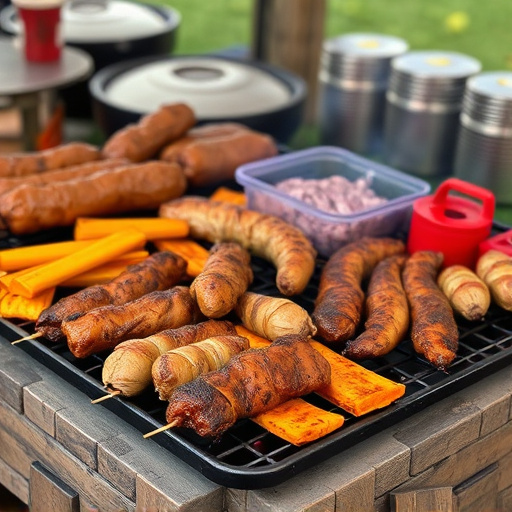Achieving perfect BBQ beef brisket starts with selecting a high-quality, well-marbled whole packer brisket and crafting a compelling dry rub seasoning. Slow cooking at 225°F–250°F (107°C–121°C) using a smoker or grill, aiming for an internal temp of 203°F (95°C), ensures tender, flavorful meat. Slicing across the grain after resting and serving with strategic side dishes enhances the dining experience.
Unleash your inner BBQ master with our simple guide to perfect BBQ beef brisket. From choosing the right cut—starting with top-quality brisket—to mastering dry rub seasoning, slow cooking techniques, and precise temperature control, we break down every step. Learn the art of setting timers and slicing to perfection, plus discover ideal pairings and sides. Elevate your BBQ game with this comprehensive BBQ beef brisket recipe.
- Choosing the Right Cut: Start With Quality Brisket
- Dry Rub Seasoning: A Simple Blend for Flavor
- Slow Cooking Technique: Mastering the Smoking Process
- Temperature Control: The Key to Tender Brisket
- Setting the Timer: Knowing When It's Ready
- Slicing and Serving: Tips for a Perfect Plate
- Pairings and Sides: Completing Your BBQ Feast
Choosing the Right Cut: Start With Quality Brisket
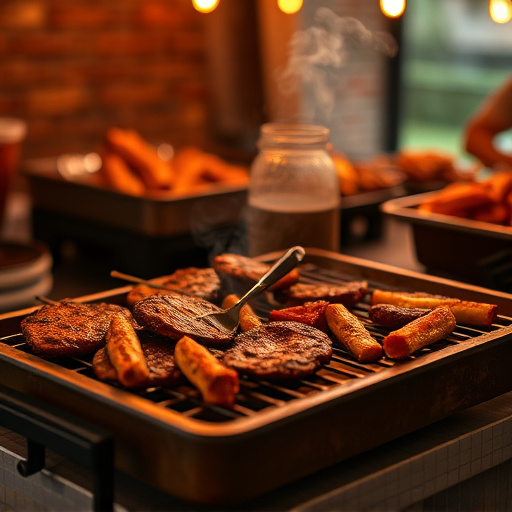
Choosing the right cut is a crucial step in achieving perfect BBQ beef brisket. Opt for a high-quality, well-marbled brisket with a good balance of fat and muscle. This ensures even cooking and maximum flavor retention. Look for a whole packer brisket, which is typically the best choice for smoking, as it offers excellent flavor and tenderness.
When selecting your BBQ beef brisket recipe, remember that the cut itself plays a significant role in the final result. A quality brisket will provide a rich, smoky taste and tender texture, making it the cornerstone of an exceptional BBQ experience. Start with a fresh, premium cut to set the stage for a truly remarkable culinary journey.
Dry Rub Seasoning: A Simple Blend for Flavor
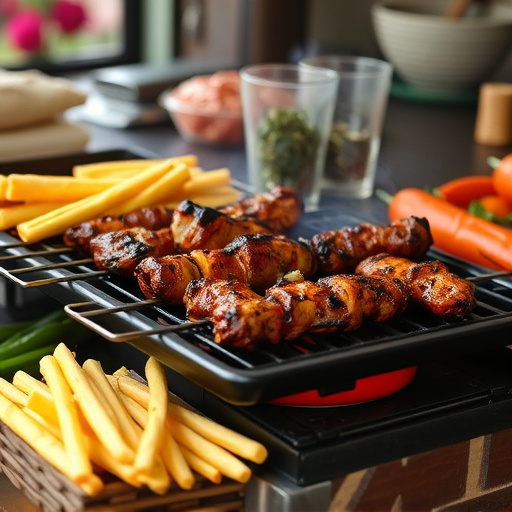
Creating a mouthwatering BBQ beef brisket starts with the perfect dry rub seasoning, which enhances the meat’s natural flavor. A simple blend can make all the difference in your barbecue game. Start by combining equal parts brown sugar (for sweetness), coarse sea salt (for a savory kick), black peppercorns (ground for a subtle heat), garlic powder, and paprika. Adjust the quantities to suit your taste preferences; a classic ratio is 2:1 sugar to salt. Optionally, add other spices like onion powder, cayenne pepper, or chili powder for added depth.
Mixing these ingredients in a bowl allows you to thoroughly coat each piece of brisket evenly. The dry rub not only adds flavor but also helps to caramelize and seal in the juices during slow cooking, resulting in tender, succulent meat. For best results, rub the brisket generously before wrapping it tightly in plastic wrap and leaving it to rest in the refrigerator for a few hours or overnight.
Slow Cooking Technique: Mastering the Smoking Process
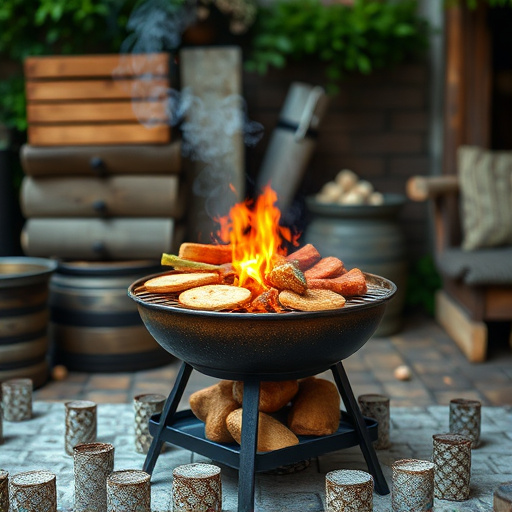
The slow cooking technique is a crucial aspect of achieving perfectly tender and flavorful BBQ beef brisket. This method allows the meat to cook gently over low heat, transforming tough cuts like brisket into melt-in-your-mouth delicacies. The smoking process, an integral part of this technique, involves using a smoker or grill with a cover to maintain a consistent temperature range between 225°F and 250°F (107°C to 121°C). This slow and steady approach ensures even cooking, preserving the brisket’s natural juices and developing a rich, smoky flavor.
Mastering the smoking process requires attention to detail. It’s essential to choose the right wood chips or chunks for smoking, as they contribute significantly to the meat’s taste and aroma. Oak, hickory, mesquite, and cherry are popular choices, each imparting distinct flavors. Regularly checking and maintaining the smoker’s temperature is key. Using a meat thermometer to monitor the internal temperature of the brisket ensures it reaches the ideal 203°F (95°C) before slicing, locking in that exquisite, smoky taste.
Temperature Control: The Key to Tender Brisket
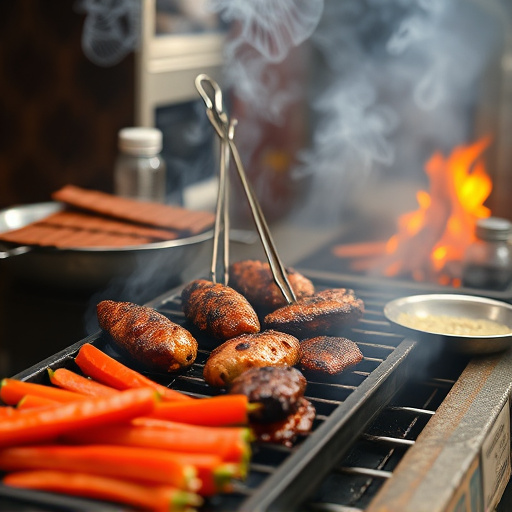
Temperature control is the golden thread that weaves together a perfect BBQ beef brisket recipe. It’s not just about cooking slowly—it’s about maintaining a consistent, low temperature to break down the tough muscle fibers in this cut of meat. Most experts recommend aiming for between 225°F (107°C) and 250°F (121°C). This slow, gentle cooking allows collagen in the brisket to transform into gelatin, resulting in incredibly tender slices that practically melt in your mouth.
A good meat thermometer is essential for navigating this process, allowing you to monitor the internal temperature of the brisket and ensure it reaches the ideal 203°F (95°C) before slicing. This precise control prevents overcooking, which can dry out the meat. Remember, slow and steady wins the race when it comes to perfecting BBQ beef brisket—letting time do its magic through gentle heat rather than high-intensity cooking methods.
Setting the Timer: Knowing When It's Ready
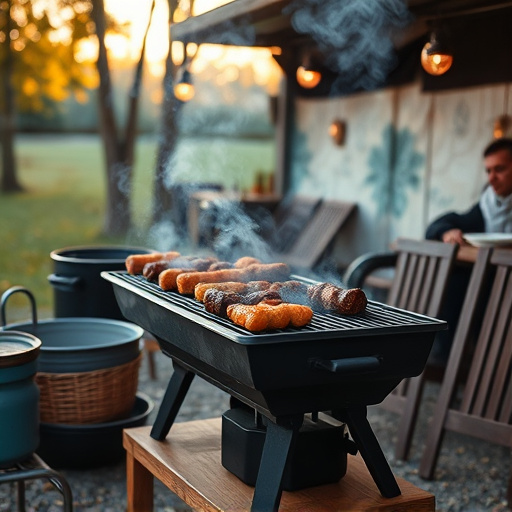
Setting the timer is a crucial step in achieving perfectly cooked BBQ beef brisket. The key to success lies in understanding that slow and steady wins the race. Brisket is a cut of meat that benefits from low-and-slow cooking, typically requiring 1 to 1.5 hours per pound at 225°F (107°C). Start by preheating your smoker or grill to the desired temperature, then place the brisket inside and secure it with butcher’s twine to maintain its shape during the cooking process. Set your timer according to the weight of the brisket and the cooking temperature.
As the meat cooks, keep a close eye on the internal temperature using a reliable meat thermometer. The ideal finish is around 203°F (95°C) for maximum tenderness. At this point, the brisket should be beautifully smoky, tender, and ready to slice. Remember, it’s better to err on the side of undercooking; BBQ beef brisket can always be warmed up a bit more if needed, but overcooking leads to dry, tough meat.
Slicing and Serving: Tips for a Perfect Plate
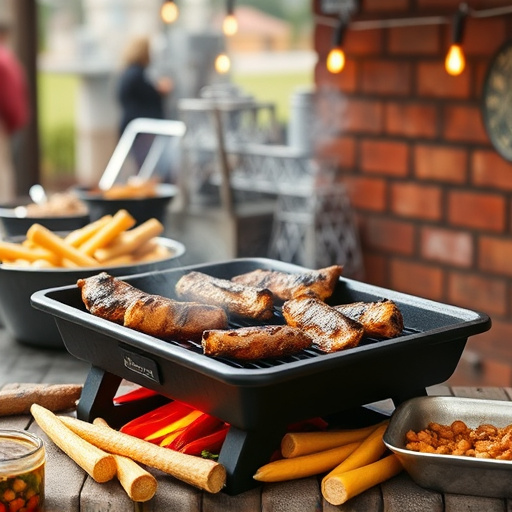
Slicing and Serving: Tips for a Perfect Plate
When it comes to serving your perfectly cooked BBQ beef brisket, the way you slice it can significantly enhance the overall dining experience. Start by removing the brisket from the smoker or oven and allowing it to rest for about 30 minutes. This resting period ensures that the juices redistribute throughout the meat, keeping it tender and juicy. Use a sharp knife, ideally a serrated one, to slice the brisket across the grain, which runs parallel to the flat side of the cut. Cutting against the grain can result in tough, stringy meat. Aim for slices that are approximately 1/4-inch thick to ensure even cooking and easy eating.
For a visually appealing plate, consider arranging the sliced brisket on a bed of your favorite BBQ sauce or alongside other traditional sides like creamy coleslaw, smoky beans, and crispy potatoes. You can also add fresh herbs and a drizzle of good quality olive oil for extra flavor. Remember, presentation matters! A beautifully plated BBQ beef brisket recipe not only looks inviting but also encourages guests to indulge in every bite.
Pairings and Sides: Completing Your BBQ Feast
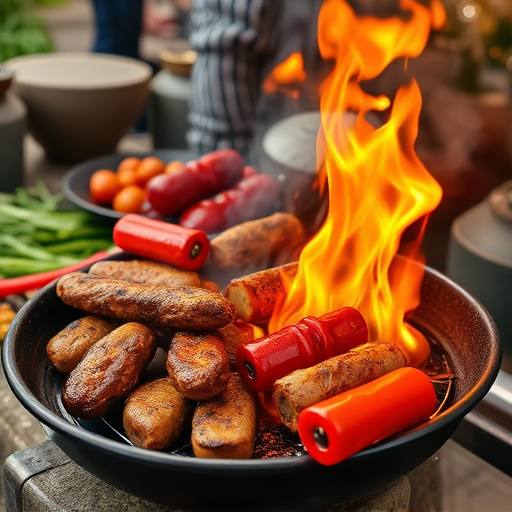
Completing your BBQ beef brisket feast involves more than just grilling the perfect slice. Pairings and sides play a crucial role in enhancing the overall dining experience. Start with traditional favorites like coleslaw, offering a crisp contrast to the tender brisket. This classic combo is a staple for a reason—the tangy cabbage slaw balances the rich, smoky meat.
For an elevated touch, consider bold flavors like grilled corn on the cob, drizzled with lime butter, or mouthwatering baked beans simmered in a tangy sauce. These sides not only complement but also complete your BBQ beef brisket recipe, creating a symphony of textures and tastes that will leave your guests craving more.
